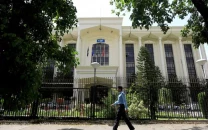Monetary policy: Why the State Bank will keep lowering interest rates
Central bank no longer believes it can control inflation through a monetary mechanism.

A subtle shift has taken place in the State Bank of Pakistan (SBP). The central bank no longer believes it can control inflation through interest rates and hence has decided to lower them to help spur economic growth.
This shift in policy has only been hinted at in the monetary policy statements that the SBP issues every two months. But it is backed up by a mountain of research being conducted inside the central bank, which suggests that raising interest rates in an attempt to control inflation rarely works in Pakistan, and that keeping interest rates high disproportionately affects small and medium-sized businesses.
A series of working papers have been put out over the last two years that reflect this change in thought. Contrary to common perception, this change is not motivated – at least at the policy analyst level – by any election-year political pressure on the State Bank. This research is coming out of the economic policy review department, the research department and the monetary policy department.
These three divisions of the State Bank have long been the best-funded economic think tank in the entire country. Over the last couple of years, they appear to have utilised their resources to question whether key assumptions in modern macroeconomics hold in Pakistan. After having conducted massive surveys, crunched the data in a scientifically rigorous manner, the answer they have come up with appears to be in the negative.
In one of the working papers, four State Bank economists challenge a key assumption of modern macroeconomics: that interest rate hikes can control inflation. In order for that to be true, prices in a country need to be “sticky”, which means that businesses should not be able to change prices frequently.
In Pakistan, however, the SBP economists discovered that the “frequency of price change is considerably high in Pakistan, lowering the real impact of monetary policy.” Specifically, they discovered that prices change roughly every two months, on average. This means that the impact of one monetary policy announcement can be completely wiped out by the time the next one rolls around.
On the other hand, another working paper analysed the impact on higher interest rates on businesses and concluded that small and medium-sized companies face a disproportionate share of the burden, hampering their capacity to grow and further solidifying the institutional advantage of being a large business.
Critics of the State Bank say that the real reason it is lowering interest rates is due to pressure from the finance ministry to lower government borrowing costs and interest payments. There may well be some truth to that. But these two working papers, along with several others, provide the SBP with solid economic, non-political cover for lowering interest rates.
There is a third, less appreciated reason for why the State Bank wants to reduce interest rates: it wants to force the banks to stop being lazy and actually lend to businesses instead of just taking in deposits and buying treasury bills. It made this “lazy banking” less feasible first by raising the minimum rate on savings accounts from 5% to 6% to increase the cost of deposits for the banks. Then it began lowering interest rates to squeeze the banks from the lending side by ensuring that they get less money from lending money to the government.
When he first came into office, State Bank Governor Yaseen Anwar said that he wanted a more diversified financial system where businesses have more options for raising capital than simply a bank loan. With the moves over the last few months, it appears that he meant what he said. That doing so also pleases the finance ministry and the presidency probably does not hurt his position either.
Regardless of why this is happening, the banking sector’s response will be interesting to watch. Expect more attention to be paid to fee-based businesses like investment banking, asset management and life insurance. McLeod Road is about to get a little more exciting.
Published in The Express Tribune, September 16th, 2012.



















COMMENTS
Comments are moderated and generally will be posted if they are on-topic and not abusive.
For more information, please see our Comments FAQ